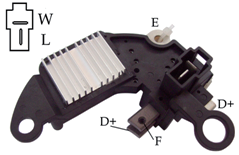An AVR or Generator Voltage Regulator is used for delivering power to the electrical fields for both brushless and commutator style exciters and will maintain the proper voltage for an AC (alternating current) generator one percent plus or minus of the exact preset value with paralleling.
A Generator Voltage Regulator is best used when a generator load alters between having zero load and a rated load with a frequency change that is greater than plus or minus four percent. When the application occurs or rejection of rated load, a generator’s voltage will recover to a plus or minus one percent within 0.3 of a second on most Generator Voltage Regulator exciters for AC (alternating current) combo.
A Generator Voltage Regulator operates best when the ambient temperature hovers around 50 degrees celsius. This creates an electrical power output of 150 W (watts) with a maximum current of 3 Amp (amperes). Each generator manufacturer operates with varying circumstances causing the AC (alternating current) generator wave length shape changes are noticeable from zero load to a rated load.
This is mainly due to the exact type of load, thus the rms (root mean square) will maintain average or peak voltage does not stay in proportion. When this occurs, for example, more than a ten percent harmonic distortion, for the voltage regulation may be outside the actual limit that is specified.
How does the Automatic Voltage Regulator operate? If a rated load is switched on to an AC (alternating current) generator the voltage will fall to around seventy percent of the no-load value. The AC (alternating current) generator voltage should be maintained closer to the no-load value. The excitation must incur a gradual increase proportionally to the amount of the load or more appropriately in proportion to the exact fall in voltage. This is the basic function of a Generator Voltage Regulator.

